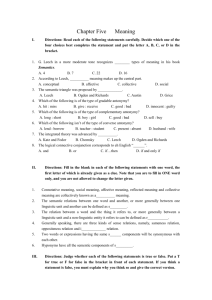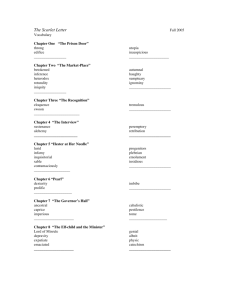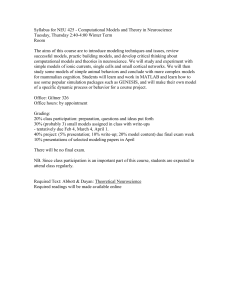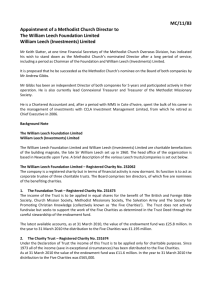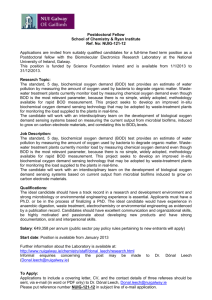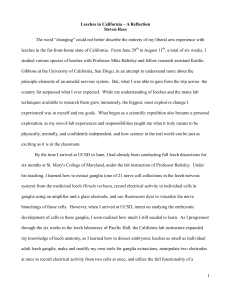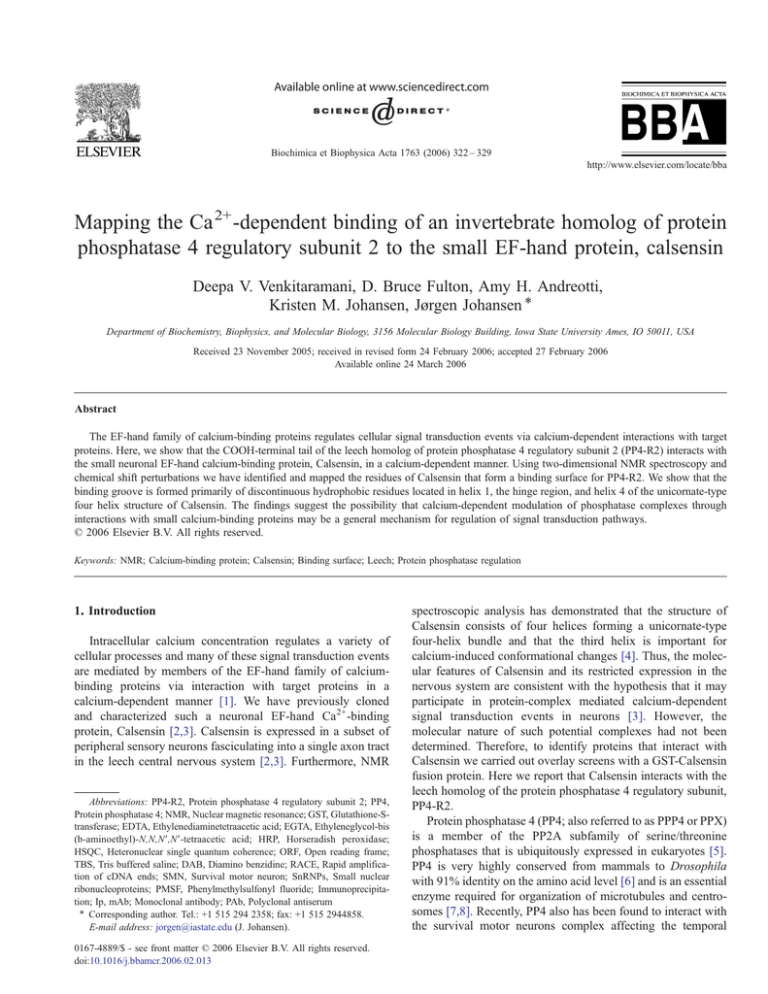
Biochimica et Biophysica Acta 1763 (2006) 322 – 329
http://www.elsevier.com/locate/bba
Mapping the Ca 2+ -dependent binding of an invertebrate homolog of protein
phosphatase 4 regulatory subunit 2 to the small EF-hand protein, calsensin
Deepa V. Venkitaramani, D. Bruce Fulton, Amy H. Andreotti,
Kristen M. Johansen, Jørgen Johansen ⁎
Department of Biochemistry, Biophysics, and Molecular Biology, 3156 Molecular Biology Building, Iowa State University Ames, IO 50011, USA
Received 23 November 2005; received in revised form 24 February 2006; accepted 27 February 2006
Available online 24 March 2006
Abstract
The EF-hand family of calcium-binding proteins regulates cellular signal transduction events via calcium-dependent interactions with target
proteins. Here, we show that the COOH-terminal tail of the leech homolog of protein phosphatase 4 regulatory subunit 2 (PP4-R2) interacts with
the small neuronal EF-hand calcium-binding protein, Calsensin, in a calcium-dependent manner. Using two-dimensional NMR spectroscopy and
chemical shift perturbations we have identified and mapped the residues of Calsensin that form a binding surface for PP4-R2. We show that the
binding groove is formed primarily of discontinuous hydrophobic residues located in helix 1, the hinge region, and helix 4 of the unicornate-type
four helix structure of Calsensin. The findings suggest the possibility that calcium-dependent modulation of phosphatase complexes through
interactions with small calcium-binding proteins may be a general mechanism for regulation of signal transduction pathways.
© 2006 Elsevier B.V. All rights reserved.
Keywords: NMR; Calcium-binding protein; Calsensin; Binding surface; Leech; Protein phosphatase regulation
1. Introduction
Intracellular calcium concentration regulates a variety of
cellular processes and many of these signal transduction events
are mediated by members of the EF-hand family of calciumbinding proteins via interaction with target proteins in a
calcium-dependent manner [1]. We have previously cloned
and characterized such a neuronal EF-hand Ca2+ -binding
protein, Calsensin [2,3]. Calsensin is expressed in a subset of
peripheral sensory neurons fasciculating into a single axon tract
in the leech central nervous system [2,3]. Furthermore, NMR
Abbreviations: PP4-R2, Protein phosphatase 4 regulatory subunit 2; PP4,
Protein phosphatase 4; NMR, Nuclear magnetic resonance; GST, Glutathione-Stransferase; EDTA, Ethylenediaminetetraacetic acid; EGTA, Ethyleneglycol-bis
(b-aminoethyl)-N,N,N′,N′-tetraacetic acid; HRP, Horseradish peroxidase;
HSQC, Heteronuclear single quantum coherence; ORF, Open reading frame;
TBS, Tris buffered saline; DAB, Diamino benzidine; RACE, Rapid amplification of cDNA ends; SMN, Survival motor neuron; SnRNPs, Small nuclear
ribonucleoproteins; PMSF, Phenylmethylsulfonyl fluoride; Immunoprecipitation; Ip, mAb; Monoclonal antibody; PAb, Polyclonal antiserum
⁎ Corresponding author. Tel.: +1 515 294 2358; fax: +1 515 2944858.
E-mail address: jorgen@iastate.edu (J. Johansen).
0167-4889/$ - see front matter © 2006 Elsevier B.V. All rights reserved.
doi:10.1016/j.bbamcr.2006.02.013
spectroscopic analysis has demonstrated that the structure of
Calsensin consists of four helices forming a unicornate-type
four-helix bundle and that the third helix is important for
calcium-induced conformational changes [4]. Thus, the molecular features of Calsensin and its restricted expression in the
nervous system are consistent with the hypothesis that it may
participate in protein-complex mediated calcium-dependent
signal transduction events in neurons [3]. However, the
molecular nature of such potential complexes had not been
determined. Therefore, to identify proteins that interact with
Calsensin we carried out overlay screens with a GST-Calsensin
fusion protein. Here we report that Calsensin interacts with the
leech homolog of the protein phosphatase 4 regulatory subunit,
PP4-R2.
Protein phosphatase 4 (PP4; also referred to as PPP4 or PPX)
is a member of the PP2A subfamily of serine/threonine
phosphatases that is ubiquitously expressed in eukaryotes [5].
PP4 is very highly conserved from mammals to Drosophila
with 91% identity on the amino acid level [6] and is an essential
enzyme required for organization of microtubules and centrosomes [7,8]. Recently, PP4 also has been found to interact with
the survival motor neurons complex affecting the temporal
D.V. Venkitaramani et al. / Biochimica et Biophysica Acta 1763 (2006) 322–329
localization of snRNPs [9]. Furthermore, PP4 has been shown
to play an important role in apoptosis, TNF-α signaling, as well
as in activation of c-Jun N-terminal kinase and NF-κB [10–13].
So far three regulatory subunits have been identified for PP4:
α4, PP4-R1, and PP4-R2 [14–18]. Thus, it is likely that PP4
participates in many essential cellular process and that the
activity of its catalytic domains is controlled by regulatory
subunits forming complex holoenzymes [19,20].
In this study, we show that the COOH-terminal tail of leech
PP4-R2 interacts with Calsensin in a calcium-dependent
manner. Furthermore, using two-dimensional NMR spectroscopy we have identified and mapped the residues of Calsensin
that form a binding surface for PP4-R2. These results indicate
the possibility that the function of the PP4 molecular complex
may be regulated by changes in intracellular calcium through
interactions with EF-hand calcium-binding proteins.
2. Materials and methods
2.1. Identification and molecular characterization of leech PP4-R2
To identify potential direct interacting partners of Calsensin we used a
purified full-length Calsensin-GST fusion protein previously described by
Venkitaramani et al. [4] to screen a Haemopis marmorata expression library. The
oligo-dT primed λgt10 EcoRI–NotI directional cDNA library [21] was plated at
a density of 30,000 pfu per 150 mm plate and a total of 106 plaques were
screened essentially according to the procedures of Sambrook and Russell [22].
The resulting nitrocellulose filters were blocked with 5% dry non-fat milk in
TBS (blotto) for 1 h and incubated overnight with 10 μg/ml of GST-Calsensin
fusion protein in blotto (blotto contains approximately 1 mg/ml of calcium) at 4
°C and washed 3 times with TBS containing 0.2% Tween-20. Positive clones
binding Calsensin-GST were identified by immunoreactivity with the Calsensin
specific mAb Lan3–6 [3], plaque purified, and the phage DNA isolated and
subcloned into pBluescript KS+/− vectors according to the method provided by
the manufacturer (Stratagene). DNA sequencing of the inserts was performed by
the Iowa State University DNA Sequencing and Synthesis Facility. The
identified sequences were compared with known and predicted sequences using
the National Center for Biotechnology Information BLAST e-mail server.
Additional NH2-terminal sequence for one of the clones with homology to
vertebrate PP4-R2 [17] was obtained using the Ambion 5′ RLM-RACE kit and
protocols. Alignments used to produce maximum parsimony trees were
generated with the Clustalw version 1.7 program and encompassed the entire
PP4-R2 sequences. Trees were constructed by maximum parsimony using the
PAUP computer program version 4.0b [23] on a Power Macintosh G4. All trees
were generated by heuristic searches and bootstrap values in percent of 1000
replications are indicated on the bootstrap majority rule consensus tree.
2.2. Biochemical analysis and antibody generation
SDS-PAGE was performed according to standard procedures [24].
Electroblot transfer was performed as in Towbin et al. [25] with transfer buffer
containing 20% methanol and in most cases including 0.04% SDS.
Immunoblots were labeled with PP4-R2 mAb 15F4 (see below), with the
Calsensin mAb Lan3–6 or with the Calsensin specific antiserum Frigg [3], with
anti-GST antibody [26], or with commercially obtained anti-biotin antibody
(Cell Signaling Technologies). For these experiments, we used the Bio-Rad
Mini PROTEAN II system, electroblotting to 0.2 μm nitrocellulose, and using
anti-mouse or anti-rabbit HRP-conjugated secondary antibody (Bio-Rad)
(1:3000) for visualization of primary antibody diluted 1:1000 in Blotto. The
signal was visualized using chemiluminescent detection methods (ECL kit,
Amersham). The immunoblots were digitized using a flatbed scanner (Epson
Expression 1680).
A full-length biotinylated Calsensin fusion protein (biot-Calsensin) was
generated by inserting the entire open reading frame of Calsensin in frame into
323
the Xa3-Pinpoint vector (Promega). Biotinylated and GST fusion proteins of
leech PP4-R2 sequence corresponding to the COOH-terminal amino acids 153–
423 identified as interacting with Calsensin in the library screen were subcloned
into the pGEX4T3 and the Xa3-Pinpoint vectors, respectively, to generate the
constructs GST-PP4-R2 and biot-PP4-R2. The three fusion-proteins were
expressed in XL1Blue or BL21 host strains and purified according to the
manufacturer's protocols. Recombinant full-length Calsensin was purified as
described below and in Venkitaramani et al. [4].
For antibody generation the GST-PP4-R2 fusion protein was expressed in
XL1-Blue cells (Stratagene) and purified over a glutathione agarose column
(Sigma-Aldrich), according to the pGEX manufacturer's instructions (Amersham Pharmacia Biotech). The mAb 15F4 was generated by injection of 50 μg
of GST-PP4-R2 into BALB/c mice at 21 d intervals. After the third boost, mouse
spleen cells were fused with Sp2 myeloma cells and monospecific hybridoma
lines were established as previously described [26]. All procedures for mAb
production were performed by the Iowa State University Hybridoma Facility.
Pulldown experiments: biot-Calsensin (2 μg) and biot-PP4-R2 (2 μg) fusion
proteins were coupled to streptavidin beads (Pierce) and used for pulldown
assays of 2 μg GST-PP4-R2 and 2 μg recombinant Calsensin, respectively, in the
presence (150 mM NaCl, 1 mM CaCl2, 0.2% Triton-X-100, 0.2% NP-40,
25 mM Tris–HCl, pH 7.4, and containing the protease inhibitors PMSF and
aprotinin) or absence of calcium (150 mM NaCl, 2 mM EDTA, 2 mM EGTA,
0.2% Triton-X-100, 0.2% NP-40, 25 mM Tris—HCl, pH 7.4, and containing the
protease inhibitors PMSF and aprotinin). The GST-PP4-R2 and Calsensin
proteins were pre-cleared by incubation with streptavidin beads before
incubation with the streptavidin beads coupled to the respective biotinylated
fusion proteins or with the beads alone overnight at 4 °C on a rotating wheel.
The beads were washed 3 times for 10 min each in 1 ml of the appropriate
calcium-free or calcium containing buffer, and proteins retained on the
streptavidin beads were analyzed by SDS-PAGE and immunoblotting.
For immunoprecipitation experiments from leech nerve cord homogenate,
10 μl of mAb Lan3–6 was coupled to 30 μl protein-G Sepharose beads (Sigma)
for 2.5 h at 4 °C on a rotating wheel in 50 μl immunoprecipitation (ip) buffer
(20 mM Tris–HCl pH 7.4, 150 mM NaCl, 1 mM CaCl2, 0.1% Triton X-100,
0.1% Nonidet P-40, 1 mM Phenylmethylsulfonyl fluoride, and 1.5 μg
Aprotinin). Subsequently the antibody-coupled beads or beads-only were
incubated overnight at 4 °C with 200 μl of dissected Haemopis nerve cord
homogenate as previously described [3] on a rotating wheel. Beads were washed
3 times for 10 min each with 1 ml of ip buffer with low speed pelleting of beads
between washes. The resulting bead-bound immunocomplexes were analyzed
by SDS-PAGE and immunoblotting. In some experiments, to test for the
specificity of the 15F4 mAb, 15 μg of the biot-PP4-R2 fusion protein was added
to the diluted antibody solution before staining.
2.3. Preparation of samples for NMR spectroscopy
Purified 15N-labeled Calsensin was obtained as described previously by
Venkitaramani et al. [4]. Escherichia coli strain BL21 (DE3) was transformed
with a full-length Calsensin-GST construct and the cultures grown in modified
M9 medium supplemented with 1 mM CaCl2 and 100 μg/ml ampicillin. For
15
N- labeled protein preparations, the modified M9 minimal media contained
15
N-enriched ammonium chloride [1 g/l, Cambridge Isotope Laboratories] as the
sole nitrogen source. Induced cells were harvested by centrifugation 12 h postinduction. The cell pellets were resuspended in 50 ml of 50 mM sodium
phosphate buffer (75 mM NaCl, 2 mM DTT and 0.02% NaN3, pH 6.0) per liter
of culture with lysozyme added to a final concentration of 1 mg/ml. After
freezing at –80 °C overnight [27] the cells were disrupted upon thawing and
protease inhibitor (1 mM PMSF) and DNase I (500 μl of 1 mg/ml stock) were
added. The cell extracts were clarified by centrifugation and the supernatant
loaded on a gluthathione-agarose (Sigma) column. The GST-fusion proteins
were eluted with 5 mM reduced glutathione in 50 mM sodium phosphate buffer,
concentrated with a Millipore stirred ultrafiltration cell, and separated on a sizeexclusion column (Sephacryl S-100 HR, Amersham Pharmacia Biotech)
equilibrated with 50 mM sodium phosphate buffer. Fractions containing the
fusion proteins were pooled, the NaCl concentration increased to 150 mM, and
the GST-tag cleaved off with thrombin by incubation at room temperature for
12–16 h. The GST-tag was subsequently removed from the recombinant
Calsensin protein using a glutathione–agarose column. The Calsensin protein
324
D.V. Venkitaramani et al. / Biochimica et Biophysica Acta 1763 (2006) 322–329
was further purified by gel-filtration (Sephacryl S-100 HR). The collected
fractions were analyzed by SDS-PAGE for purity, pooled, and concentrated to
1–2 mM for NMR experiments. The final NMR samples contained 10% 2H2O.
2.4. NMR spectroscopy
All NMR data were acquired at 298K on a Bruker DRX500 spectrometer
operating at 1H frequency of 499.867 MHz. A 5 mm triple-resonance (1H/15N/
13
C) probe with XYZ field gradients was used for all experiments. A gradientenhanced HSQC experiment with minimal water saturation [28] was used for all
1
H–15N correlation experiments. 1H–15N HSQC spectra were obtained for
0.8 mM 15N-labeled purified recombinant Calsensin either in calcium-free
buffer (50 mM Na2PO4, 75 mM NaCl, 2 mM DTT, 8 mM EDTA, 0.02% NaN3,
pH 6.0) corresponding to the apo form of Calsensin or in the same buffer with 32
equivalents of CaCl2 added to obtain the calcium-bound holo form. At this level
of Ca2+-concentration no additional spectral shifts were observed due to
increased calcium-levels indicating that Calsensin was fully calcium-bound. The
spectra from fully calcium-bound Calsensin were compared to spectra after
adding increasing amounts of unlabeled carboxyl-terminal fragment (aa 153–
423) of PP4-R2 purified from the GST-PP4-R2 fusion protein as described
above for Calsensin to a final concentration of 0.8 mM. Due to precipitation of
the protein 0.8 mM was the maximum concentration obtainable. The normalized
chemical shift deviations were calculated from Δav = [(ΔHN)2 + ΔN/5)2]1/2 [29].
To estimate the dissociation constant of the Calsensin/PP4-R2 interaction,
uniformly labeled 0.8 mM 15N Calsensin was similarly titrated with increasing
amounts of unlabeled carboxyl-terminal PP4-R2 and the changes monitored by
recording 1H–15N HSQC spectra. The resulting normalized chemical shift
deviations are a measure of the ligand occupancy of Calsensin. The digital
resolution of the spectra was 0.001 ppm. Seven residues (L9, D37, K68, E69,
L72, N73 and C80) with minimal spectral overlap were selected and used for
calculating the dissociation constant as described in Breheny et al. [30].
The data were processed on a Linux workstation using the NMRPIPE
software package [31] and assignments were carried out using NMRView [32].
All structures were visualized and rendered using MOLMOL [33].
3. Results and discussion
To identify proteins that have direct interactions with
Calsensin and that may play a role in calcium-dependent signal
transduction processes we performed an overlay screen of a
leech expression library with GST-Calsensin fusion protein.
Potential positive clones detected by labeling with the Calsensin
specific mAb Lan3–6 were retested, plaque-purified, subcloned, and sequenced. Seven different candidate clones
identified in this way were subsequently inserted into the
Xa3-Pinpoint vector to generate biotinylated fusion proteins for
pull-down interaction assays with Calsensin. These assays
confirmed three of the identified clones as potential interaction
partners of Calsensin and one of these which contained an
extensive carboxyl-terminal fragment (Fig. 1A, underlined
sequence) interacted with Calsensin in a calcium-dependent
manner (see below). For this reason, the latter clone was chosen
for further study and the complete open reading frame
nucleotide sequence obtained by 5′ RACE extension. The
predicted amino acid sequence (GenBank: DQ363933) encodes
a protein of 423 residues (Fig. 1A) with a molecular mass of
46.7 kDa and with a low isoelectric point of 4.5. TBlastN
searches of the NCBI databases showed that the most closely
related proteins to this leech sequence were those of the protein
phosphatase 4 regulatory subunit 2 family. PP4-R2 was first
identified in mammals as a 453 amino acid protein with a
molecular mass of 50.4 kDa that forms complexes with PP4
[17]. Mammalian PP4-R2 has a characteristic 43 residue
conserved region in the NH2-terminal half of the protein that
Fig. 1. The predicted protein sequence and phylogenetic relationship of leech PP4-R2. (A) The complete 1269 nt open reading frame derived from the leech PP4-R2
cDNA translates into a 423 aa protein with a predicted molecular mass of 46.7 kDa. The COOH-terminal sequence identified by its interaction with Calsensin in the
screen is underlined. (B) Sequence alignment of leech PP4-R2 with vertebrate members of the PP4-R2 family: human PP4-R2long (CAB93534), human PP4-R2short
(NP_777567), chicken (NP_001006142), rat (XP_216225), mouse (BAC38523) and zebrafish (AAH60912). The position of this sequence in leech PP4-R2 is
indicated by the boxed region in panel A. Identical residues are highlighted in black while similar residues are shown in grey. (C) Phylogenetic relationship of leech
PP4-R2 with the vertebrate PP4-R2 family members listed in panel B. The consensus maximum parsimony tree was derived from an alignment of the entire sequences.
The tree is unrooted and is depicted with the associated bootstrap support values from 1000 iterations.
D.V. Venkitaramani et al. / Biochimica et Biophysica Acta 1763 (2006) 322–329
was predicted to form an α-helical structure [17]. Fig. 1B shows
an alignment of this region from representative vertebrate PP4R2 proteins with the corresponding leech sequence which
shows a high level of conservation (70% amino acid identity).
Furthermore, we used alignments covering the entire amino acid
sequence of these proteins to construct maximum parsimony
phylogenetic trees. Fig. 1C shows that the leech sequence,
which has 63% overall sequence similarity to human PP4-R2,
forms a monophylectic clade with zebrafish PP4-R2 with 98%
bootstrap support. Interestingly, the acidic nature of the leech
protein is also shared by mammalian PP4-R2 which has a
similarly low isoelectric point of 4.7 [17]. Taken together, these
325
data strongly suggest that the identified leech protein is a
homolog of vertebrate PP4-R2 proteins and in the following it
will therefore be referred to as leech PP4-R2. Other potential
invertebrate homologs of PP4-R2 previously have been
identified in flies and worms [17].
In order to verify the interaction between Calsensin and leech
PP4-R2 we performed pull-down assays with biotinylated fulllength Calsensin (biot-Calsensin) and carboxyl-terminal (aa
153–423) leech PP4-R2 GST-fusion protein (GST-PP4-R2) in
the presence (1 mM) and absence of calcium (Fig. 2A). The
biot-Calsensin fusion protein was coupled to streptavidin beads,
incubated with GST-PP4-R2 fusion protein, washed,
Fig. 2. Calsensin interacts with leech PP4-R2 in pulldown and immunoprecipitation assays. (A) Leech COOH-terminal GST-PP4-R2 fusion protein (aa 153–423)
incubated with biotinylated Calsensin (biot-Cal) or with a beads only control was pelleted with streptavidin beads in the presence or absence of 1 mM calcium and the
interacting protein fractionated by SDS-PAGE, immunoblotted, and probed with GST-antibody. The input biot-Cal protein detected with biotin-antibody is shown in
lane 1 whereas the input GST-PP4-R2 protein detected with GST-antibody is shown in lane 2. Biotinylated-Calsensin was able to pull-down GST-PP4-R2 in the
presence of calcium as detected by the GST-antibody (lane 4); however, the pull-down activity by biot-Calsensin was greatly reduced in the absence of calcium (lane
3). The streptavidin beads-only controls showed no pull-down activity (lane 5). (B) Leech COOH-terminal biotinylated-PP4-R2 (biot-PP4-R2) fusion protein (aa 153–
423) incubated with purified recombinant Calsensin or with a beads only control was pelleted with streptavidin beads in the presence or absence of 1 mM calcium and
the interacting protein fractionated by SDS-PAGE, immunoblotted, and probed with the Calsensin specific mAb Lan3–6. The input biot-PP4-R2 protein detected with
biotin-antibody is shown in lane 1 whereas the input Calsensin protein detected with the mAb Lan3–6 is shown in lane 2. Biotinylated-PP4-R2 was able to pull-down
Calsensin in the presence of calcium as detected by the mAb Lan3–6 (lane 4); however, there was no pull-down activity by biot-PP4-R2 in the absence of calcium (lane
3). The streptavidin beads-only controls showed no pull-down activity (lane 5). (C) Immunoblot analysis of protein extracts from leech nerve cords (nce) shows that
mAb 15F4 recognizes leech PP4-R2 as a 51 kDa band (lane 1) and that this labeling is abolished by preincubation with biot-PP4-R2 fusion protein (lane 2).
Immunoprecipitation (ip) of leech nerve cord extracts were performed using Calsensin antibody (mAb Lan3–6, lane 5) or with immunobeads only as a control (lane 4).
The immunoprecipitations were analyzed by SDS-PAGE and Western blotting using PP4-R2 mAb 15F4 for detection. PP4-R2 antibody staining of nerve cord extract
is shown in lane 3. PP4-R2 is detected in the ip sample as a 51 kDa band (lane 5) but not in the control sample (lane 4). The ratio of total lysate loaded to that used for
the immunoprecipitation experiments was 1:10. (D) Immunoblot analysis of protein extracts from leech nerve cords (nce) shows that mAb Lan3–6 ips Calsensin as a 9
kDa band (lane 2) also present in the nerve cord extracts (lane 1) as detected by the Calsensin-specific antiserum, Frigg. The relative migration of molecular weight
markers is indicated to the right of the immunoblots in kDa.
326
D.V. Venkitaramani et al. / Biochimica et Biophysica Acta 1763 (2006) 322–329
fractionated by SDS-PAGE, and analyzed by immunoblot
analysis using GST-antibody (Fig. 2A). Whereas the streptavidin beads-only controls showed no pull-down activity, biot-
Calsensin was able to pull-down GST-PP4-R2 in the presence
of calcium as detected by the GST-antibody. However, the pulldown activity by biot-Calsensin was greatly reduced in the
Fig. 3. Chemical shift mapping of the binding of carboxyl-terminal leech PP4-R2 to Calsensin. (A) Superimposed 1H–15N HSQC spectra of 0.8 mM 15N-labeled
Calsensin in calcium-free buffer with (red spectrum) and without (blue spectrum) 0.8 mM of unlabeled leech carboxyl-terminal PP4-R2 protein. (B) Superimposed
1
H–15N HSQC spectra of 0.8 mM 15N-labeled fully calcium-bound Calsensin with (red spectrum) and without (blue spectrum) 0.8 mM of unlabeled leech COOHterminal PP4-R2 protein. The inserts in panels A and B show expanded views of the boxed regions. (C) Normalized chemical shift differences in ppm of 1H and 15N
resonances of free Calsensin and Calsensin bound to COOH-terminal PP4-R2 protein obtained from 1H–15N HSQC spectra. The chemical shifts are from fully
calcium-bound Calsensin and plotted as a function of residue number. The secondary structure of Calsensin is depicted at the top and the dotted line indicates the
average chemical shift perturbation per residue (0.017 ppm). (D) Plot of the chemical shift changes of the 15N-resonances of seven different residues of Calsensin as a
function of the concentration of added leech PP4-R2 protein. The concentration of 15N-labeled Calsensin in the calcium-bound holo form was 0.8 mM. The continuous
curve represent the best fit theoretical binding curve with a equilibrium dissociation constant of 157 ± 70 μM (n = 5). (For interpretation of the references to colour in
this figure legend, the reader is referred to the web version of this article.)
D.V. Venkitaramani et al. / Biochimica et Biophysica Acta 1763 (2006) 322–329
absence of calcium (Fig. 2A, lane 3). In the reciprocal pulldown experiments a carboxyl-terminal (aa 153–423) leech PP4R2 biotinylated fusion protein (biot-PP4-R2) coupled to
streptavidin beads was incubated with purified full-length
recombinant Calsensin and analyzed as described above (Fig.
2B). Whereas the streptavidin beads-only control and biot-PP4R2 in the absence of calcium showed no pull-down activity,
biot-PP4-R2 was able to pull-down Calsensin in the presence of
calcium as detected by the Calsensin specific mAb Lan3–6.
These results strongly suggest that Calsensin and leech PP4-R2
are present in the same protein complex and that this interaction
is calcium-dependent.
In order to identify leech PP4-R2 on immunoblots we
generated a mAb, 15F4, to the GST-PP4-R2 fusion protein. On
immunoblots of leech nerve cord extracts this antibody
recognizes a single band migrating at approximately 51 kDa
which is close to the predicted molecular mass of leech PP4-R2
of 46.7 kDa (Fig. 2C). The 51 kDa band immunoreactivity was
specifically competed away if the antibody was preadsorbed
with biot-PP4-R2 fusion protein (Fig. 2C, lane 2). These results
strongly indicate that mAb 15F4 specifically recognizes leech
PP4-R2 on immunoblots. Unfortunately, in subsequent experi-
327
ments mAb 15F4 proved not to be suitable for immunoprecipitation or immunocytology assays. However, in order to test for
an in vivo interaction between PP4-R2 and Calsensin we
extracted leech nerve cord proteins and immunoprecipitated
with Calsensin mAb Lan3–6, fractionated the immunoprecipitated proteins on SDS-PAGE, immunoblotted, and probed with
the PP4-R2 mAb 15F4. Fig. 2C shows such an immunoprecipitation experiment where the co-immunoprecipitate of the
Calsensin mAb is detected as a 51 kDa band also present in
the nerve cord extracts. This band was not present in lanes where
immunobeads-only were used for the immunoprecipitation. Fig.
2D confirms that mAb Lan3–6 was able to immunoprecipitate
Calsensin from the nerve cord extracts. These results provide
evidence that leech PP4-R2 and Calsensin are present in the
same protein complex in leech nerve cords in vivo.
To further characterize the binding of the COOH-terminal
tail of leech PP4-R2 to Calsensin we performed chemical shift
mapping using 1H–15N HSQC experiments. Resonance assignments and a high-resolution 3D solution structure of calciumbound Calsensin were previously obtained [4]. Fig. 3A shows a
1
H–15N HSQC spectrum (in blue) of 0.8 mM 15N-labeled
purified recombinant Calsensin in calcium-free buffer (50 mM
Fig. 4. Mapping of residues exhibiting significant chemical shift change upon complexation with leech carboxyl-terminal PP4-R2 protein on the solution structure of
calcium-bound Calsensin. (A) Surface plot of Calsensin. The regions coloured in blue have positive electrostatic potential, those coloured in red have negative
electrostatic potential, and the regions in white are neutral. The hydrophobic residues in helices 2, 3, and 4 as well as in the hinge region are exposed to the surface. The
backbone structure of Calsensin is shown in panel B, whereas (C) shows two orthogonal views of molecular surface representations. Residues coloured in green, red,
and brown have normalized chemical shift values >0.06 ppm, >0.03 pm, and >0.02 ppm, respectively. The blue surface indicate that that there is no significant 1H/15N
shift perturbation. All plots were rendered using MOLMOL [33]. (For interpretation of the references to colour in this figure legend, the reader is referred to the web
version of this article.)
328
D.V. Venkitaramani et al. / Biochimica et Biophysica Acta 1763 (2006) 322–329
Na2PO4, 75 mM NaCl, 2 mM DTT, 8 mM EDTA, 0.02% NaN3,
pH 6.0) corresponding to the apo form of Calsensin. After
adding up to 0.8 mM of unlabeled purified carboxyl-terminal
PP4-R2 fusion protein (aa 153–423) (higher concentrations
lead to precipitation) there were no significant chemical shifts in
the 1H–15N HSQC spectrum (Fig. 3A, spectrum in red)
suggesting that there is no measurable interaction between
Calsensin and COOH-terminal PP4-R2 under these conditions.
Fig. 3B shows a 1H–15N HSQC spectrum of 15N-labeled
Calsensin (spectrum in blue) in the fully calcium-bound holo
form with 32 equivalents of calcium added to the buffer. Under
these conditions in the presence of 0.8 mM purified carboxylterminal PP4-R2, significant chemical shift changes were
observed for a subset of residues (Fig. 3B, spectrum in red).
The normalized chemical shifts calculated from Δav = [(ΔHN)2 +
(ΔN/5)2]1/2 [29] and plotted as a function of residue number is
shown in Fig. 3C. In addition, the residues with the largest
chemical shift perturbations (> 0.02 ppm) are mapped onto the
calcium-bound 3D solution structure of Calsensin [4] in Fig. 4B
and C. Calsensin has a potential shallow, binding groove formed
primarily by hydrophobic residues located in helix 1, the hinge
region, and helix 4 [4] (Fig. 4A). As illustrated in Fig. 4B and C,
almost all of the residues with the largest chemical shift
perturbations were located in this region of the protein. These
chemical shift perturbations were similar to those obtained for
the residues determining the interaction between the third
extracellular domain of the interleukin-6 receptor and its ligand
[34] and for the residues responsible for DNA-binding to the E.
coli cell division activator protein CedA [35]. To estimate the
dissociation constant of the Calsensin/PP4-R2 interaction, we
titrated uniformly labeled 0.8 mM 15 N Calsensin with
increasing amounts of purified unlabeled carboxyl-terminal
PP4-R2 and monitored the changes by recording 1H–15N
HSQC spectra. The system is in fast exchange on the NMR time
scale. Thus the normalized chemical shifts values are a measure
of the ligand occupancy of Calsensin. Unfortunately, due to
precipitation of the PP4-R2 carboxyl-terminal fragment at
concentrations higher than 0.8 mM, we could not saturate the
binding interaction. However, from the dependence of normalized chemical shift on ligand concentration that was obtained,
we estimated a dissociation constant Kd, of 157 ± 70 μM [27,30]
for the interaction between Calsensin and the carboxyl-terminal
fragment of PP4-R2 (Fig. 3D). These data strongly suggest that
the binding of leech PP4-R2 maps to a well-defined binding
surface of Calsensin and that especially residues A7, L9, L72
and C80 are involved in this interaction.
Immunolocalization studies of PP4 in rat have shown a
widespread distribution in all tissues examined with particularly
high levels in brain and testes [36]. Within cells, both PP4 and
PP4-R2 were found in an overlapping pattern throughout the
cytoplasm and nucleus but with more intense staining in the
nucleus and at centrosomes [17,36,37]. In addition, many
protein phosphatase complexes are located in distinct regions of
the cell and are targeted to these subcellular locations by their
regulatory subunits [17]. Thus, specific phosphatase functions
may be conferred by the regulatory subunits of the holoenzyme
in a tissue and cell context dependent manner [5]. Calsensin is
expressed in only a small subset of neurons many of which
fasciculate in a single axon tract [2,3]. The calcium-dependent
interaction between Calsensin and leech PP4-R2 demonstrated
in this study therefore has the potential to regulate phosphatase
activity in these neurons and modulate specific signal
transduction processes governing the functional properties of
these neurons. Furthermore, the findings raise the possibility
that calcium-dependent modulation of phosphatase complexes
through interactions with small calcium-binding proteins such
as the S100 family may be a general mechanism for regulation
of signal transduction pathways.
Acknowledgements
This work was supported by NIH grant NS28857. The
authors wish to thank Dr. Monica Sundd for valuable discussions during the preparation of the manuscript. We also appreciate the technical help provided by Jayandran Palaniappan.
References
[1] B.W. Schafer, C.W. Heizmann, The S100 family of EF-hand calciumbinding proteins: functions and pathology, Trends Biochem. Sci. 21 (1996)
134–140.
[2] K.K. Briggs, K.M. Johansen, J. Johansen, Selective pathway choice of a
single central axonal fascicle by a subset of peripheral neurons during
leech development, Dev. Biol. 158 (1993) 380–389.
[3] K.K. Briggs, A. Silvers, K.M. Johansen, J. Johansen, Calsensin: a novel
calcium-binding protein expressed in a subset of peripheral leech neurons
fasciculating in a single axon tract, J. Cell Biol. 129 (1995) 1355–1362.
[4] D.V. Venkitaramani, D.B. Fulton, A.H. Andreotti, K.M. Johansen, J.
Johansen, Solution structure and backbone dynamics of Calsensin, an
invertebrate neuronal calcium-binding protein, Protein Sci. 14 (2005)
1894–1901.
[5] S. Wera, B.A. Hemmings, Serine/threonine protein phosphatases,
Biochem. J. 311 (1995) 17–29.
[6] N.D. Brevis, P.T.W. Cohen, Protein phosphatase X has been highly
conserved during mammalian evolution, Biochim. Biophys. Acta 1171
(1992) 231–233.
[7] N.R. Helps, N.D. Brewis, K. Lineruth, T. Davis, K. Kaiser, P.T.W. Cohen,
Protein phosphatase 4 is an essential enzyme required for organization of
microtubules at centrosomes in Drosophila embryos, J. Cell Sci. 111
(1998) 1331–1340.
[8] E. Sumiyoshi, A. Sugimoto, M. Yamamoto, Protein phosphatase 4 is
required for centrosome maturation in mitosis and sperm meiosis in C.
elegans, J. Cell Sci. 115 (2002) 1403–1410.
[9] G.K. Carnegie, J.E. Sleeman, N. Morrice, C.J. Hastie, M.W. Peggie, A.
Philp, A.I. Lamond, P.T.W. Cohen, Protein phosphatase 4 interacts with the
survival of motor neurons complex and enhances the temporal localization
of snRNPs, J. Cell Sci. 116 (2003) 1905–1913.
[10] M.C.-T. Hu, Q. Tang-Oxley, W.R. Qiu, Y. Wang, K.A. Mihindukulasuriya,
R. Afshar, T. Tan, et al., Protein phosphatase X interacts with c-Rel and
stimulates c-Rel/nuclear factor κB activity, J. Biol. Chem. 273 (1998)
33561–33565.
[11] G. Zhou, K.A. Mihindukulasuriya, R.A. MacCorkle-Chosnek, A.
VanHooser, M.C.-T. Hu, B.R. Brinkley, T.-H. Tan, Protein phosphatase
4 is involved in tumor necrosis factor-alpha-induced activation of c-Jun Nterminal kinase, J. Biol. Chem. 277 (2002) 6391–6398.
[12] M. Mourtada-Maarabouni, L. Kirkham, B. Jenkins, J. Rayner, T.J. Gonda,
R. Starr, I. Trayner, F. Farzaneh, G.T. Williams, Functional expression
cloning reveals proapoptotic role for protein phosphatase 4, Cell Death
Differ. 10 (2003) 1016–1024.
[13] P.Y. Yeh, K.-H. Yeh, S.-E. Chuang, Y.C. Song, A.-L. Cheng, Suppression
of MEK/ERK signaling pathway enhances cisplatin-induced NF-κB
D.V. Venkitaramani et al. / Biochimica et Biophysica Acta 1763 (2006) 322–329
[14]
[15]
[16]
[17]
[18]
[19]
[20]
[21]
[22]
[23]
[24]
[25]
[26]
activation by protein phosphatase 4-mediated NF-κB p65 Thr dephosphorylation, J. Biol. Chem. 279 (2004) 26143–26148.
J. Chen, R.T. Peterson, S.L. Schreiber, Alpha 4 associates with protein
phosphatases 2A, 4, and 6, Biochem. Biophys. Res. Commun. 247 (1998)
827–832.
M. Nanahoshi, Y. Tsujishita, C. Tokunaga, S. Inui, N. Sakaguchi, K. Hara,
K. Yonezawa, Alpha4 protein as a common regulator of type 2A-related
serine/threonine protein phosphatases, FEBS Lett. 446 (1999) 108–112.
S. Kloeker, B.E. Wadzinski, Purification and identification of a novel
subunit of protein serine/threonine phosphatase 4, J. Biol. Chem. 274
(1999) 5339–5347.
C.J. Hastie, G.K. Carnegie, N. Morrice, P.T.W. Cohen, A novel 50 kDa
protein forms complexes with protein phosphatase 4 and is located at
centrosomal microtubule organizing centres, Biochem. J. 347 (2000)
845–855.
T. Wada, T. Miyata, R. Inagi, M. Nangaku, M. Wagatsuma, D. Suzuki, B.E.
Wadzinski, K. Okubo, K. Kurokawa, Cloning and characterization of a
novel subunit of protein serine/threonine phosphatase 4 from mesangial
cells, J. Am. Soc. Nephrol. 12 (2001) 2601–2608.
K.A. Mihindukulasuriya, G. Zhou, J. Qin, T.-H. Tan, Protein phosphatase
4 interacts with and down-regulates insulin receptor substrate 4 following
tumor necrosis factor—A stimulation, J. Biol. Chem. 279 (2004)
46588–46594.
P.T.W. Cohen, A. Philp, C. Vazquez-Martin, Protein phosphatase 4—From
obscurity to vital functions, FEBS Lett. 579 (2005) 3278–3286.
Y. Huang, J. Jellies, K.M. Johansen, J. Johansen, Differential
glycosylation of Tractin and LeechCAM, two novel Ig superfamily
members, regulates neurite extension and fascicle formation, J. Cell Biol.
138 (1997) 143–157.
J. Sambrook, D.W. Russell, Molecular Cloning: A Laboratory Manual,
Second ed.Cold Spring Harbor Laboratory, Cold Spring Harbor, NY, 2001.
D.L. Swofford, Phylogenetic analysis using parsimony, Illinois Natural
History Survey, Champaign, IL, 1993.
U.K. Laemmli, Cleavage of structural proteins during assembly of the head
of bacteriophage T4, Nature 227 (1970) 680–685.
H. Towbin, T. Staehelin, J. Gordon, Electrophoretic transfer of proteins
from polyacrylamide gels to nitrocellulose sheets: procedure and some
applications, Proc. Natl. Acad. Sci. U. S. A. 76 (1979) 4350–4354.
U. Rath, D. Wang, Y. Ding, Y.-Z. Xu, H. Qi, M.J. Blacketer, J. Girton, J.
Johansen, K.M. Johansen, Chromator, a novel and essential chromo-
[27]
[28]
[29]
[30]
[31]
[32]
[33]
[34]
[35]
[36]
[37]
329
domain protein interacts directly with the putative spindle matrix protein
Skeletor, J. Cell. Biochem. 93 (2004) 1033–1047.
K.N. Brazin, D.B. Fulton, A.H. Andreotti, A specific intermolecular
association between the regulatory domains of a Tec family kinase, J. Mol.
Biol. 302 (2000) 607–623.
S. Mori, C. Abeygunawardana, M. O'Neil Johnson, P.C.M. van Zijl,
Improved sensitivity of HSQC spectra of exchanging protons at short
interscan delays using a new fast HSQC (FHSQC) detection scheme that
avoids water saturation, J. Magn. Reson., B 108 (1995) 94–98.
I. Radhakrishnan, G.C. Perez-Alvarado, D. Parker, H.N. Dyson, M.R.
Montminy, P.E. Wright, Structural analyses of CREB-CBP transcriptional
activator–coactivator complexes by NMR spectroscopy: implications for
mapping the boundaries of structural domains, J. Mol. Biol. 287 (1999)
859–865.
P.J. Breheny, A. Laederach, D.B. Fulton, A.H. Andreotti, Ligand
specificity modulated by prolyl imide bond cis/trans isomerization in the
Itk SH2 domain: a quantitative NMR study, J. Am. Chem. Soc. 125 (2003)
15706–15707.
F. Delaglio, S. Grzesiek, G.W. Vuister, G. Zhu, J. Pfeifer, A. Bax,
NMRPipe: a multidimensional spectral processing system based on UNIX
pipes, J. Biomol. NMR 6 (1995) 277–293.
B.A. Johnson, R.A. Blevins, NMRView: a computer program for the
visualization and analysis of NMR data, J. Biomol. NMR 4 (1994)
603–614.
R. Koradi, M. Billeter, K. Wuthrich, MOLMOL: a program for display
and analysis of macromolecular structures, J. Mol. Graph. 14 (1996)
51–55.
A. Schwantner, A.J. Dingley, S. Özbek, S. Rose-John, J. Grötzinger,
Direct determination of the interleukin-6 binding epitope of the
interleukin-6 receptor by NMR spectroscopy, J. Biol. Chem. 279 (2004)
571–576.
H.A. Chen, P. Simpson, T. Huyton, D. Roper, S. Matthews, Solution
structure and interactions of the Escherichia coli cell division activator
protein CedA, Biochemistry 44 (2005) 6738–6744.
S. Kloeker, J.C. Bryant, S. Strack, R.J. Colbran, B.E. Wadzinski,
Carboxymethylation of nuclear protein serine/threonine phosphatase X,
Biochem. J. 327 (1997) 481–486.
N.D. Brevis, A.J. Street, A.R. Prescott, P.T.W. Cohen, PPX, a novel protein
serine/threonine phosphatase localized to centrosomes, EMBO J. 12
(1993) 987–996.

